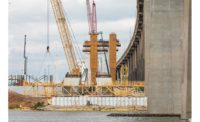A collision near the Houston Ship Channel on March 22 involving a 585-ft bulk carrier and a barge containing 924,000 gal of bunker fuel sent oil straight into Galveston Bay, the gateway to one of the busiest ports in the U.S.
The U.S. Coast Guard has estimated that about 168,000 gal of oil were released following the collision. “Some of that has already been recuperated and they’re still working on the cleanup,” says Rosio Torres, spokesperson at the Joint Information Center, the Unified Command Center for what’s being called the Texas City “Y” Incident.
According to the Coast Guard, at approximately 12:35 p.m. Saturday, the captain of the bulk carrier Summer Wind reported a collision between the carrier and an oil barge being towed by the motor vessel Miss Susan.
Kirby Inland Marine, owner of the Miss Susan and the barges, activated its emergency response plan immediately and has been working in a unified response with the Coast Guard and the Texas General Land Office.
Approximately 70 response vessels are actively working to skim and recover oil with more than 539 personnel on-scene, with another 218 supporting responding in the incident command post, Torres says.
Officials reported Tuesday that there is approximately 15.5 miles of nonconsecutive impacted shoreline. Response personnel have collected approximately 164,892 gal of oil-water mixture as well as 852 bags of solid waste. A majority of the solid waste was collected from Big Reef, Pelican Island, East Beach and Texas City Dike. The waste products include oiled debris, oil sand mixture and snare boom.
Additionally, the National Oceanic and Atmospheric Administration has reported evaporation of 16,800 gal and a natural dispersion rate of 1,680 gal of spilled fuel oil.
So far, response teams have deployed more than 71,000 ft of containment boom on waters surrounding the incident site and along sensitive shorelines in the area. An additional 232,600 ft of boom has been staged for possible deployment and another 5,400 ft ordered, according to officials.
Lightering operations to transfer remaining oil from the damaged barge into a second barge were completed on Sunday, the day after the collision. The amount of oil recovered from the barge itself has not yet been determined, Torres says.
Meanwhile, choppy weather conditions have pushed oil recovery plans and efforts into the Gulf of Mexico and south along Galveston Island, according to the Coast Guard. To further ensure the safety of response workers and prevent the spread of oil into other areas, a safety zone was established restricting traffic in impacted waters.













Post a comment to this article
Report Abusive Comment